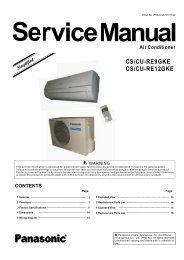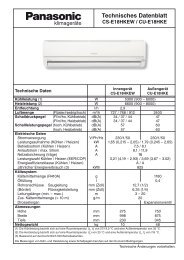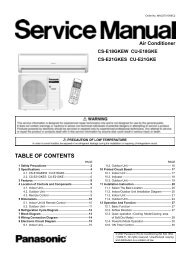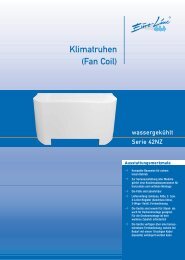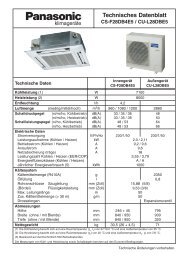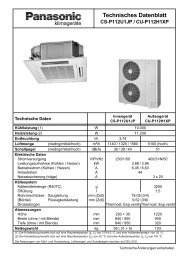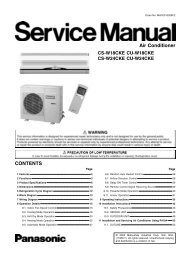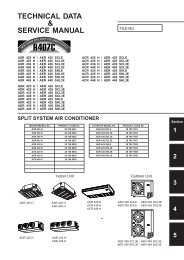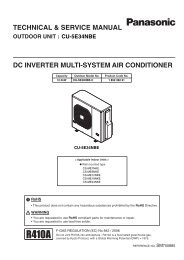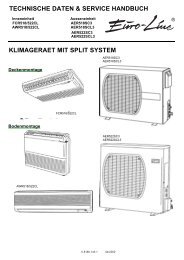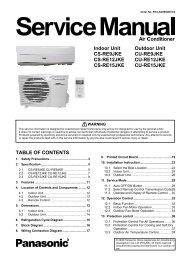Panasonic Air Conditioner
Panasonic Air Conditioner
Panasonic Air Conditioner
Create successful ePaper yourself
Turn your PDF publications into a flip-book with our unique Google optimized e-Paper software.
11.3. Refrigerant piping work<br />
11.3.1. Piping materials<br />
It is recommended that you use copper and copper alloy jointless pipes with a maximum oil adherence of 40 mg/10m. Do not use<br />
pipes that are crushed, deformed, or discolored (especially the inside surface). If these inferior pipes are used, impurities may clog<br />
the expansion valves or capillaries.<br />
Because the pressure of ACs using R410A is higher than those using R22, it is essential that you select materials that are appropriate<br />
for these standards.<br />
The thickness of the copper tubing used for R410A is shown in Table 10. Please be aware that tubing with a thickness of only 0.7<br />
mm is also available on the market, but this should never be used.<br />
Table 10 Copper tube thickness (mm)<br />
Soft pipe Thickness (mm)<br />
Nominal diameter Outside diameter (mm) R410A (Reference) R22<br />
1/4 6.35 0.80 0.80<br />
3/8 9.52 0.80 0.80<br />
1/2 12.7 0.80 0.80<br />
5/8 15.88 1.00 1.00<br />
11.3.2. Processing and connecting piping materials<br />
When working with refrigerant piping, the following points must<br />
be carefully observed: no moisture or dust must be allowed to<br />
enter the piping, and there must be no refrigerant leaks.<br />
1. Procedure and precautions for flaring work<br />
a. Cut the pipe<br />
Use a pipe cutter, and cut slowly so the pipe will not<br />
be deformed.<br />
b. Remove burrs and clean shavings from the cut surface<br />
If the shape of the pipe end is poor after removing<br />
burrs, or if shavings adhere to the flared area, it may<br />
lead to refrigerant leaks.<br />
To prevent this, turn the cut surface downward and<br />
remove burrs, then clean the surface, carefully.<br />
c. Insert the flare nut (be sure to use the same nut that is<br />
used on the AC unit)<br />
d. Flaring<br />
Check the clamp bar and the cleanliness of the copper<br />
pipe.<br />
Be sure to use the clamp bar to do the flaring with<br />
accuracy. Use either an R410A flaring tool, or a conventional<br />
flaring tool. Flaring tools come in different<br />
sizes, so be sure to check the size before using.<br />
When using a conventional flaring tool, use the copper<br />
pipe gauge for clearance adjustment, etc., to<br />
ensure the correct A dimension (see Fig. 10)<br />
Fig. 11 Relation between the flare nut structure and flaring tool end<br />
74<br />
Fig. 10 Flaring dimensions



